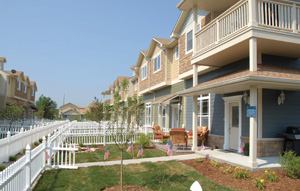Jeff Burton, president of American Dream Development, raised more than a few eyebrows when he bought the site of an old drive-in theater on Grant Avenue in Junction City, Kan., to build a townhome neighborhood. No one had ever built for-sale townhomes in Junction City, a community of about 19,000 people, about an hour west of Topeka, Kan.
If that weren’t enough, the property was in a flood plain where several hundred homes had been wiped out in 1993. Plus, it was surrounded by trailer parks, and the only businesses nearby were several adult-entertainment establishments. Other businesses on the street had closed when the Army’s Fort Riley closed its gates to the public after 9/11. Once a base with easy public access, businesses thrived along the road leading into the base. When the gates were closed to the public, traffic along the road dwindled.
“It was a pretty downtrodden area,” Burton admits.
But Burton, a former regional manager for KB Home, was used to working with challenging conditions—and eager to apply the systems he learned as a production builder to his own company in an area poised for rapid growth. Fort Riley is home to the Army’s First Infantry Division, known the world over as the Big Red One. With the division’s headquarters transferring from Germany to Fort Riley, Junction City’s population is expected to nearly double in the next five years. Burton’s community, The Village at Freedom Place, is five minutes from Fort Riley’s front gate.
The Village at Freedom Place was “a very large step” in the revitalization of the Grant Avenue corridor, says Terry Heldstab, a Junction City commissioner who was mayor when Burton first proposed the project. It easily obtained the approval of the city commission, Heldstab says, but he didn’t realize the magnitude of what Burton was planning until it started to come out of the ground.
“It’s such a neighborhood concept,” Heldstab says. “They don’t have big, huge yards, but you really get a feeling of community. … [Burton has] brought a really nice product to Junction City.”
Since opening for sale in January 2006, The Village at Freedom Place has been the top seller in the area, which has about 35 builders, Burton says. This year, The Village at Freedom Place has a full 35 percent of Junction City’s new-home sales.
LESSONS FROM THE BIG GUYS Burton used every tool he learned at KB Home to drive down costs. He started with the site’s infrastructure, cutting costs in half by running water, sewer, and stormwater lines down the middle of the property instead of around the perimeter. His grading plan eliminated the need for $200,000 worth of retaining walls—originally included to achieve the needed flow on the sewer lines—and received the same result with a $30,000 lift station. Then he brought in enough fill to raise the site out of the flood plain and screened it from the trailer parks and adult businesses.
To help reduce the appearance of a very dense product, Burton used three colors on each home’s elevation—one color on the first floor, another on the second floor, and a third for a band around the windows. “[In] every other development here, they paint everything the same color,” he says.
The placement of the three- and four-bedroom townhomes, which face each other, helps foster interaction between neighbors and provide a safe place for children to play, says architect Brett Deam. The tri-color elevations, with stone accents and James Hardie siding, help bring the buildings down to scale. “When you put six or eight units across from each other, it gets pretty massive,” he says.
Learn more about markets featured in this article: Kansas City, MO, Manhattan, KS.



